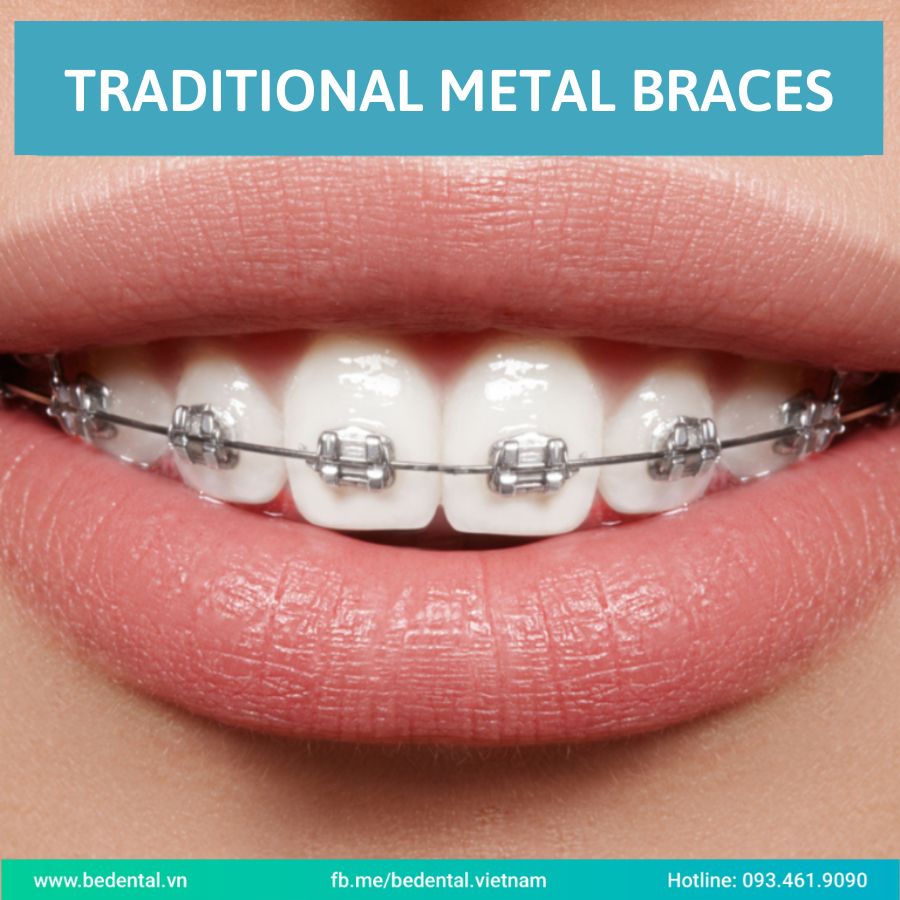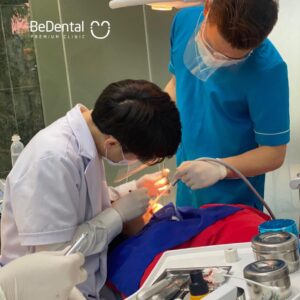Metal braces: This method is the foundation of modern orthodontic braces that have existed for a long time and are effective for correcting crooked, underbite, sparse and misaligned teeth from easy to complex. … with stainless steel alloys such as nickel-titanium, metal braces have strong durability and have an even and stable effect.
What are metal braces ?
Traditional metal braces use brackets fixed on the teeth, the arch wire is on the brackets, and the arch wire is fixed to the brackets by tying the dental elastic. The elasticity of the dental rubber band will support for the orthodontic process to take place continuously and stably, thereby achieving the most wanted effect.

Metal braces: Pros and cons
Pros:
- The least expensive method compared to others
- High effectiveness
- Can solve complex orthodontic cases
- Less time consuming
- Durable material
Cons:
- They are the most noticeable of all types of braces.
- Can be quite painful due to the pressure being applied to teeth.
- Properly cleaning teeth and gums can be a time-consuming task with braces scince it’s more difficult
- Braces limit the types of foods and drinks that can consume
- Customers must regularly visit doctors and change the elastic during the process of braces
See more: Ceramic braces
How long do traditional braces take?
On average, it takes about 24 months to complete an orthodontic treatment. Some patients require less than 12 months, but there are also patients requiring up to 3 years of treatment before their teeth reach the desired position.
Why are metal braces widely used?
Metal braces are widely used because they are effective in correcting a wide range of dental issues, including overcrowding, crooked teeth, overbite, underbite, and crossbite. Metal braces are also durable and can withstand the force required to move teeth into their correct positions. Additionally, metal braces are typically the most affordable option for orthodontic treatment, making them accessible to a wide range of patients. Finally, metal braces have been used for many years and have a proven track record of success in achieving beautiful, straight smiles.
Metal braces vs ceramic braces
Metal braces vs lingual brace
Do metal braces require tooth extraction?
Depending on patient’s oral situation, here are some cases require tooth extraction:
- Misaligned jaw, extra teeth
- Underbite
- Macrodontia, hyperdontia
- Extract tooth number 8 when it is misaligned, crashing into tooth number 7
At BeDental, our dentist will help patient brace and don’t have to do tooth extraction with the support of Damon and F.A.C.E method
The process

Step 1: The doctor conducts a general examination of the patient’s oral health through X-ray to detect dental diseases. You may need to have dental treatment if there’s any diseases
Step 2: The doctor will make a detailed and accurate orthodontic treatment plan.
Step 3: Signing contract
Step 4: Oral hygiene and remove tartar before the procedure
Step 5: Attach the upper jaw braces first, after getting used to eating and drinking, will continue to attach the lower jaw in 1-2 weeks
Step 6: Once complete, the doctor advises on how to take care of your teeth to get the best results, also schedule an appointment. In each re-examination, brackets, wires, anchors will be adjusted accordingly.
Step 7: After the teeth are in the right position and beautiful, the dentist will remove the braces. At the same time, the customer will wear a retainer to ensure that the teeth are not displaced.
Where can you get the services ?
For highly effective braces , you need to choose a dental clinic that is trusted and reputable.

With the best dental professionals in Vietnam, BeDental is a popular address for providing dental services and a leader of the dentistry field with the support of advanced technology. Bedental confidently commits to help you have a beautiful, bright smile.
Client’s feedback



Taking Care of Your Braces
Taking care of your braces is important to ensure that they function properly and to maintain good oral hygiene. Here are some tips for taking care of your braces:
- Brush and floss regularly: Brush your teeth at least twice a day and floss at least once a day. Use a soft-bristled brush and fluoride toothpaste to clean your teeth and braces thoroughly.
- Avoid hard and sticky foods: Hard and sticky foods can damage your braces, so avoid eating hard candies, popcorn, nuts, and other similar foods.
- Wear a mouthguard when playing sports: If you play sports, wear a mouthguard to protect your braces and teeth from impact.
- Avoid chewing on objects: Chewing on pencils, pens, or other objects can damage your braces, so avoid doing so.
- Use orthodontic wax: If your braces are causing irritation or sores in your mouth, use orthodontic wax to cover the brackets and wires.
- Attend regular check-ups: Visit your orthodontist regularly to ensure that your braces are working properly and to make any necessary adjustments.
By following these tips, you can ensure that your braces are well-cared for and that your teeth and gums stay healthy throughout your treatment.

